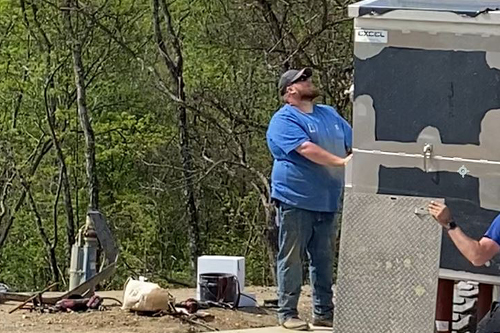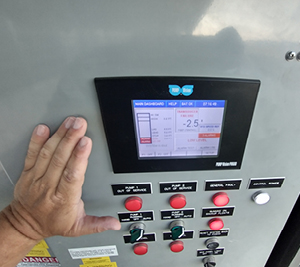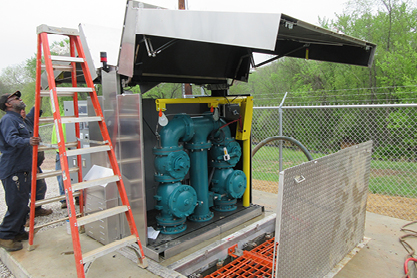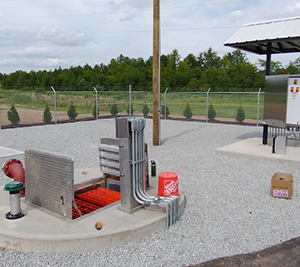 Pump Station Maintenance Tips
Pump Station Maintenance Tips
Josh Montgomery is a field service technician here at Excel Fluid Group. He doesn’t sit in an office. In the field servicing, maintaining, commissioning and improving pump stations is Josh’s territory. He earned his stripes on a municipal maintenance team servicing pumps and lift stations. We sat down with Josh to ask him about his tips for pump station service and upkeep. With experience on both sides of the fence, he has a wealth of knowledge when it comes to pump station preservation. Here are his 10 real-world insights for pump station service:
1. What should a routine maintenance consist of?
While it varies from station to station, routine pump station maintenance should check the incoming flow compared to the designed operating point, amp draw and voltage updates, and look for debris or any abnormalities around the site. Most items become obvious when you do the basic performance tests, such as access hatch condition, locking mechanisms, and warning or alarm lights. A visual check in the wet well can give a quick indication whether the station is clean and operational, or in need of serious service.
2. How often should you check your pump station?
When I was with the city, we would do a drive by daily to be aware of any visual changes or concerns, always taking a moment to document the check. On a weekly basis, check the electronics and get flow rate and amp numbers, again documenting for reference. You want to check the pump logs to see if one pump is running longer than the other, or if there is a drastic difference in flow between the pumps.
3. How does that change during the lifetime of the pump station?
We recommend completing a deep inspection of the pump station’s components every 5 years, especially if issues are frequently occurring. For example, if the pumps are continually clogging you might want to move to chopper pumps or add a trash basket to the inlet. When it comes to the electronics, infrared reading can look for hotspots and predict failures before they occur. This gives you the time to prepare a replacement on a schedule instead of emergency. You want to track if there is a change of use since the pump station was originally designed. This could include an increase or decrease in population and daily use, consistency of the wastewater, or anything else not accounted for over the lifetime of the station.
4. Speaking on that, how can a system account for changing flows with a change in population draining to it?
A pump station design point is great to build from but is ultimately still a prediction of the future. If there is an unforeseen change in the pump station’s flow, check if larger, more efficient pumps are needed. If there is the opposite issue where a decrease in flow is seen, we recommend checking the pump cycles. If a station hasn’t run on a daily basis, we recommend manually cycling it. Similar to a car motor, you don’t want to components to sit and get stale. The machine must be exercised. Sometimes a new business or residence gets added to a collection system that creates a lot of trouble, such as a Truck Stop or Assisted Living Center with unexpected products in the waste stream. Upgrading the pump selection can be an easy fix.

5.When running a typical inspection, what is your main focal point when performing maintenance on the controls?
When checking the controls of a station you first want to make sure the electronics are still calibrated properly. This can easily be done by checking the level settings to make sure there is not a negative number or an outrageously large number in the PLC. You should also check to see if there have been any power outages between visits. Power outages can wreak havoc on a pump station’s electronics.
6. Power outages obviously aren’t good on any electrical component but what weak points should especially be checked after an outage?
First and foremost, make sure you still have your alarm logs and that nothing was lost during the power reset. From there, check to see if all your components are running as intended. If not, hard resets should get the station back to factory conditions. However, we have seen pumps fail to run in Auto from the factory setting. This can be for a variety of reasons depending on when the system was interrupted. Check to make sure the floats aren’t hung up partway down or sitting on top of a layer of fats/grease. From there, confirm your pump station is cycling automatically as required.
7. What have you found are the best ways to prevent float issues within the wet well?
The best way to prevent float issues is to install them with the needed spacing, and keep the station clean. This means hanging the floats so they’re not directly in front of the inlet. Be cognizant that they are set where they won’t get sucked into the pump. Lastly, keep them clean. With FOGs (fats, oils, and greases) within the wet well, floats tend to try to float on top of thick buildup layers. This could cause discrepancies in the levels and cause pumps to run over their needed use.
8. What have you found to be the biggest culprit of pumps clogging and what do you suggest to fix it?
Inorganic solids not intended for the waste stream have become more and more of an issue. Before intended use, look for construction debris like gravel, mud, paint, drywall tape, and more that can cause problems from start up. Often the pump station goes in early in the development and unwanted construction debris and mud/gravel flow in. After start up, during intended use, we’ve seen “flushable” wipes, up to 1/8 inch rags cause blockages on a consistent basis. With an increase in water saving appliances, there is just less liquid to push solids within the waste stream. Chopper and grinder pumps have been proven to handle these solids by cutting them into pieces 3 inches or less. We can bring the Barnes SITHE Chopper Pump trailer to do a demonstration if you want to see it up close and personal – you’ll be impressed.
9. What is the strangest blockage or piece of debris that you’d seen?
It was after new construction. I had a 2 inch hole saw core that made it through the piping and then perfectly fit in the bottom of the pumps and clogged it whole. It was perfectly stuck until I had to pull the pump out of the wet well completely to dislodge it. Crazy stuff gets into waste streams, but a properly designed and well maintained pump station is your best chance of avoiding critical downtime.
10. Have you ever dealt with wildlife at a pump station?
Of course, many times! We could film some nature shows, not all with a happy ending unfortunately. There’s been mice, raccoons, and possums that I’ve had to evict to make sure they weren’t chewing on any wires. I’d have to say bees are probably the worst. I don’t think I’ve been to a station in the last three years that hasn’t had at least one bee. They like to make nests in all the nooks and crannies that a pump station provides. Some of this can be part of the daily or weekly monitoring before it leads to an infestation. Bring a can of bee spray along, you’re likely to need it.
BONUS: What do you think is the best way to keep up with your pump station’s health?
The easiest way is regular inspections. Myself and the rest of our team are available to provide check ups with our Maintenance Plus program. We provide annual, semi-annual, or quarterly plans where we’ll perform pump performance and electrical checks, valve operation check, level control checks, and more. This will be a way for us to support your efforts in ongoing maintenance that includes the daily to weekly inspections. From the electronics perspective, SCADA Systems help provide you with the information that keeps your electronic components healthy for your long-term use.

We hope this helps gives you a better understanding of the best ways to maintain and upkeep your pump station. We also have a blog that breaks down the differences in maintenance between the NoVault™ and conventional pump station designs. Check out six ways we’ve found to eliminate confined space entry during pump station maintenance. If you have any questions on your pump station safety, contact us today!




